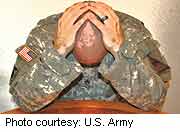
WEDNESDAY, July 23, 2014 (HealthDay News) — U.S. servicemen are more likely to have been exposed to some form of childhood trauma than their civilian counterparts, a large, new survey suggests.
The finding seems to apply solely to military men, not women.
The research team suggested that the finding could be a cause for concern, given that early childhood exposure to various forms of physical, mental, and/or sexual abuse among the civilian population has been linked to a higher adult risk for depression, drug abuse and suicidal tendencies.
“At this point, we are not clear what may be driving the higher percentage [of childhood trauma],” said study author John Blosnich, a researcher with the Center for Health Equity Research and Promotion in the U.S. Department of Veterans Affairs at the Veterans Affairs Pittsburgh Healthcare System. “This first study is only a signal that showed there was difference. [And] as with many initial studies like this, it raises more questions than it answers.”
Blosnich and his colleagues report their findings online July 23 in the journal JAMA Psychiatry.
To explore the prevalence of childhood trauma among members of the military, the study authors analyzed telephone interviews conducted throughout 2010 among nearly 61,000 men and women by the Behavioral Risk Factor Surveillance System.
One-quarter of the men and 2 percent of the women had a military background.
All were asked to recount negative childhood events experienced before the age of 18, including: living with a person who was depressed, mentally ill or suicidal; living with an alcohol or drug abuser; living with someone who had been in prison; living in a separated or divorced household; witnessing parental violence; and/or being subject to physical, verbal or sexual abuse.
By all measures, men who had voluntarily served in the military after 1973 were more likely to have lived through a negative childhood experience.
For example, those with a post-1973 military background were twice as likely to have experienced various forms of childhood sexual abuse.
In contrast, almost no differences were seen when comparing non-military men with men whose military career unfolded pre-1973, when the draft mandated military service. The exception: drug use in their childhood home was actually significantly less common among pre-1973 military men relative to their non-military peers.
Among women, differences were not so apparent, regardless of whether they served before or after 1973. The exception: volunteer servicewomen were more likely to say they had been touched sexually as a child.
The study authors suggested that the findings might reflect an attraction to the military among men searching for a way out of a difficult situation.
Regardless, Blosnich said it remains to be seen whether the greater propensity of childhood trauma among male service members actually translates into long-term trouble down the road. In fact, he noted that “associations between adverse childhood experiences and adverse outcomes previously observed among the general public have not, as yet, been definitively established in military populations.”
“Traditionally, those who serve in our nation’s military have better health than those without comparable service history,” he added. “[So] it is possible that the education, training, structure and fellowship of the military may help to buffer those negative early life experiences.”
Christopher Wildeman, an associate professor of policy analysis and management at Cornell University, pointed out some caveats in the findings.
“In terms of whether this all implies that somehow the military is staffed with so-called ‘damaged goods,’ I would say it’s critical to drive home the point that even if a quarter of military men have experienced an adverse event during childhood, that still means that fully three in four did not,” he said.
“I’d also say that this study doesn’t suggest exactly how traumatic these events were, or how consistently they were experienced, which is not to minimize the experiences, but just to know that numbers don’t always speak to the nature of what happened,” Wildeman noted.
“And in terms of what could explain this, my sense is that as a rough estimate probably three-quarters of the difference is driven by differences in socioeconomic backgrounds, meaning disadvantaged households,” he said. “And selection into the military on the basis of socioeconomic disadvantage and hardship is broadly well known.”
“And if you perhaps pair that with parenting styles that emphasize toughness and resilience and making it through adversity, it might explain why you’d end up with kids who have a rough childhood but who are also more excited and prepared for military service as a result,” Wildeman continued. “It’s complicated. And we don’t know. But it makes some sense.”
More information
The U.S. Department of Veterans Affairs offers a variety of mental health services for soldiers.
Copyright © 2025 HealthDay. All rights reserved.

